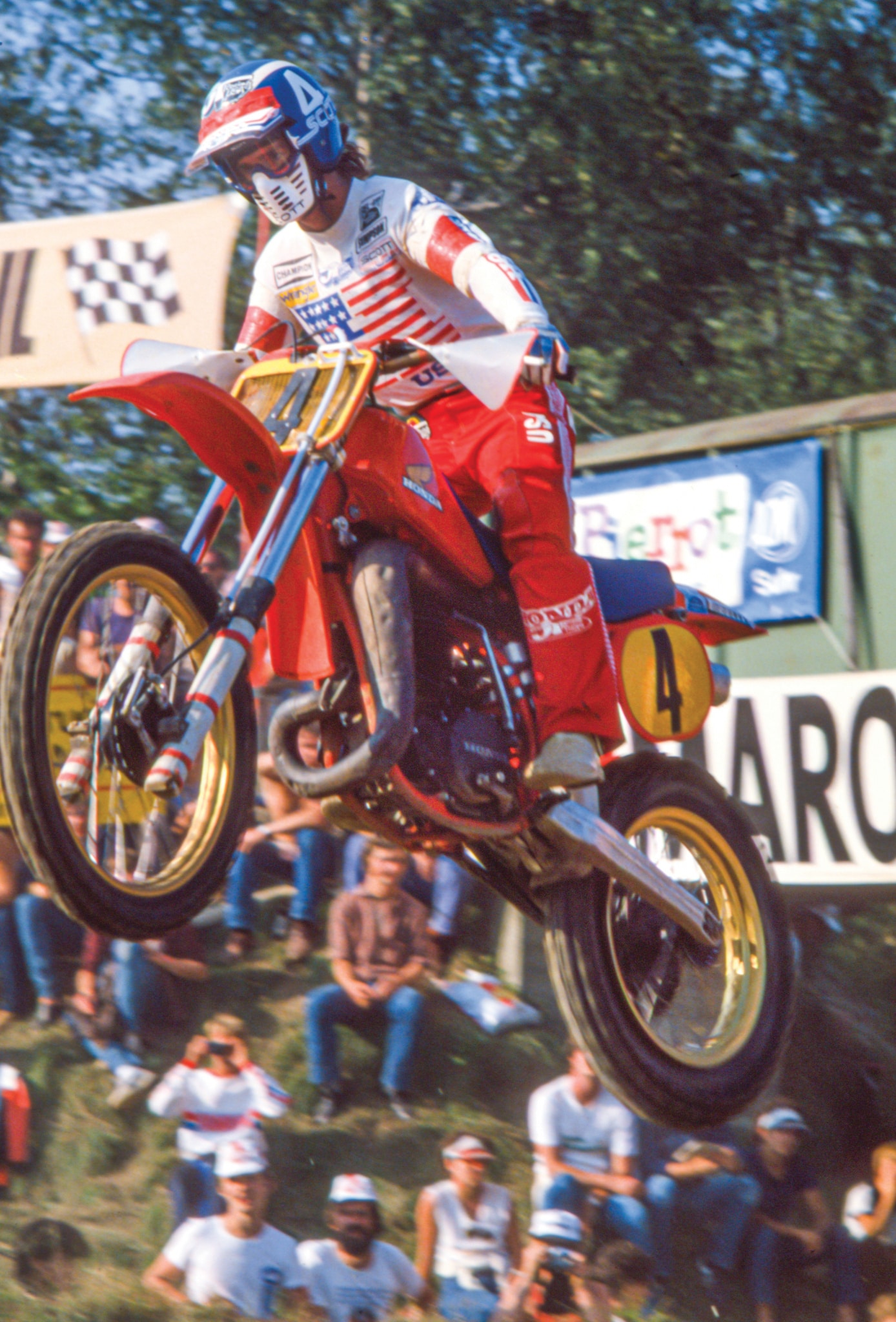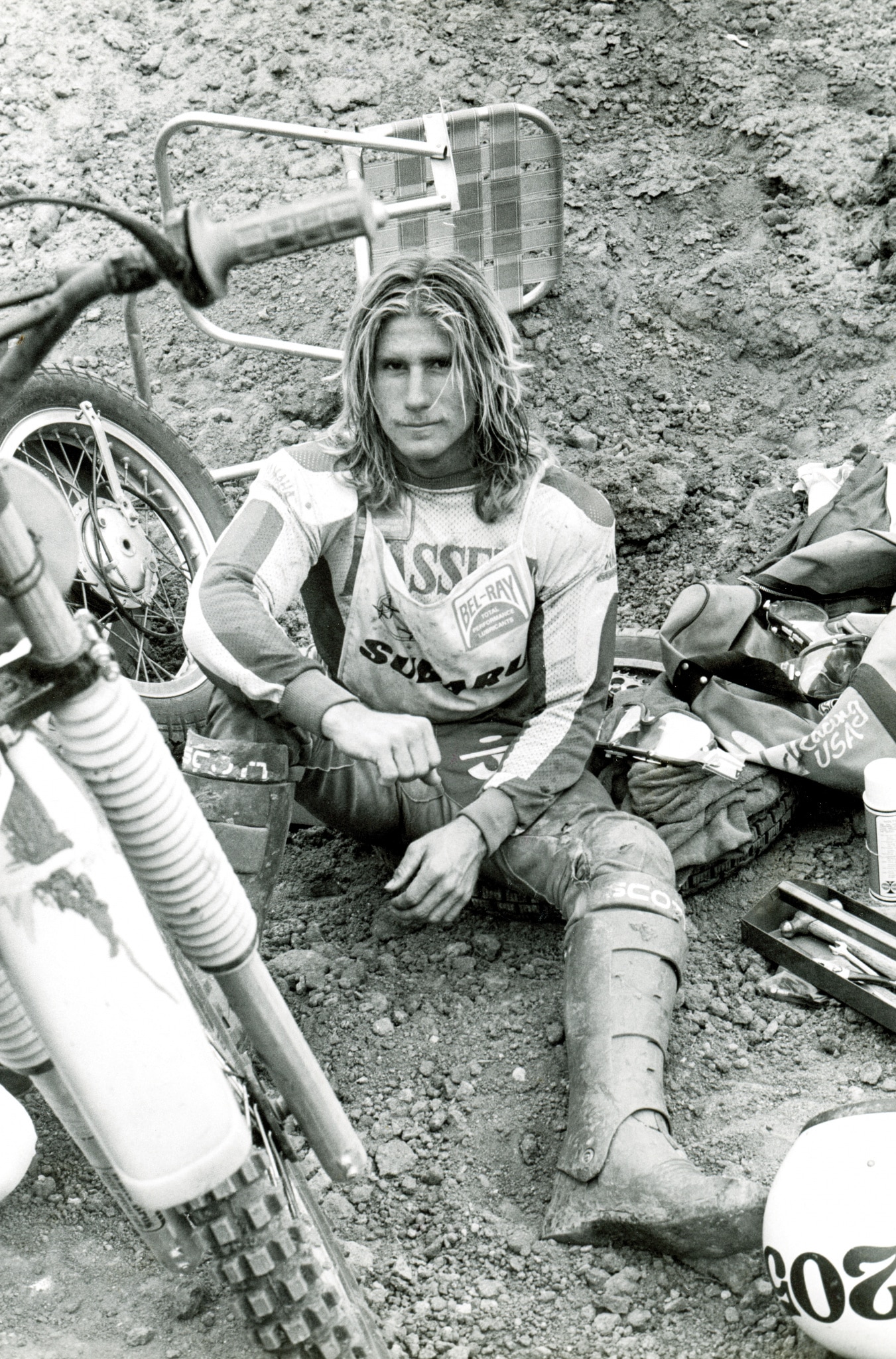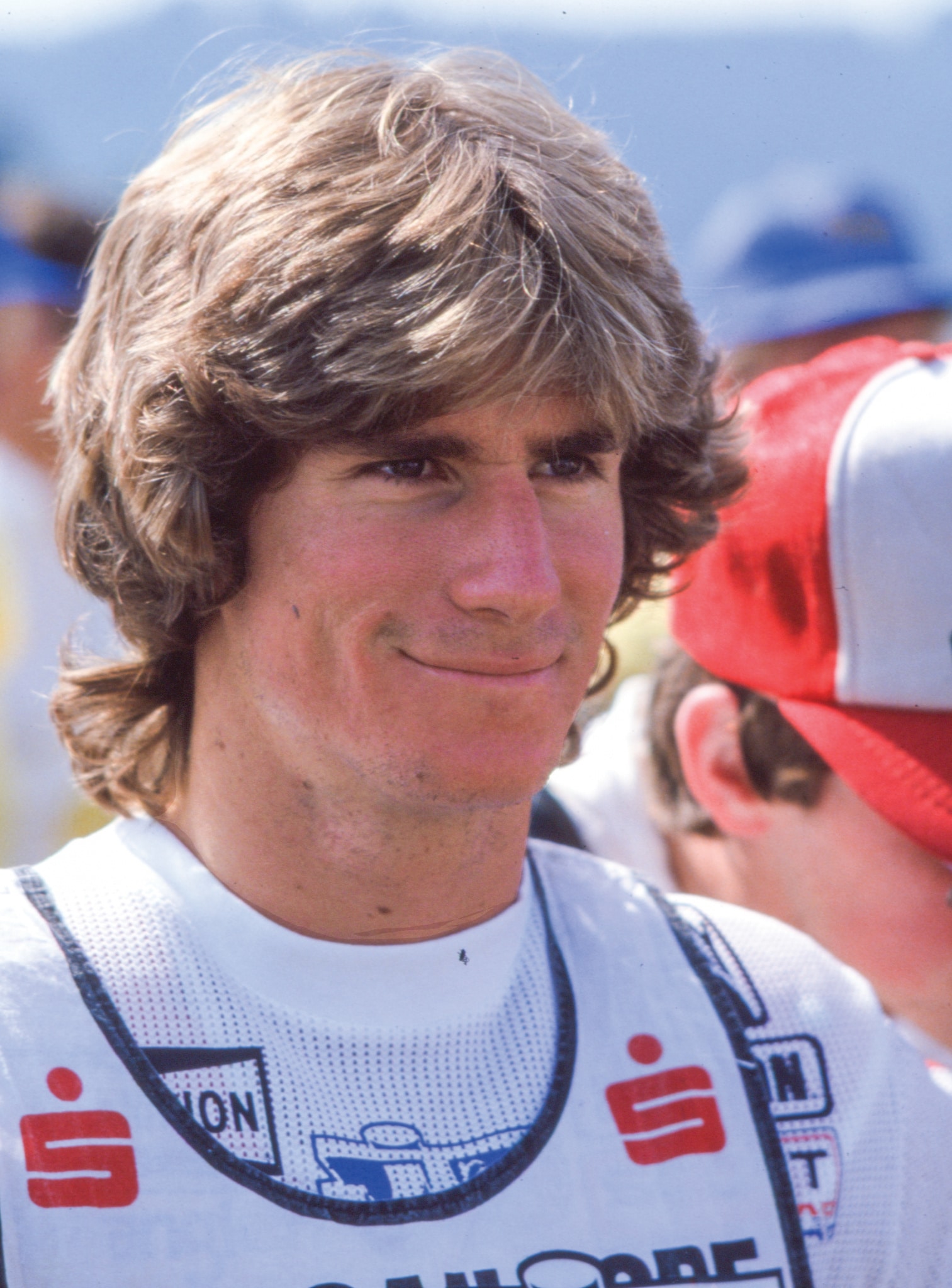MXA INTERVIEW: JIM GIBSON ON THE BEAUTY OF BEING IN THE ZONE
 Flying high at the 1982 Motocross des Nations.
Flying high at the 1982 Motocross des Nations.
BY JIM KIMBALL
HOW DID YOU BEGIN RIDING DIRT BIKES? I got into it late. I bought my Taco minibike when I was 9. I used to go up and down the driveway. It was a natural progression. I had no plans, no goals, no nothing. When I first saw this Taco minibike, I told my dad I wanted one. He said, “You will have to earn the money and save up.” So, I saved my $150 to buy the Taco minibike, but he took me to the Honda shop where we saw the Mini Trail 50, which was $300. I really wanted that, but I said, “I don’t have enough money.” Dad said, “Well, I will go in half with you.” I bought half of my first motorcycle at 9 years old and bought every motorcycle after that. I never really had a sponsor buy me a motorcycle until about halfway into my relationship with Bassett Racing.
WHEN DID YOU DECIDE TO RACE? After the Mini Trail 50, I went to a stripped-down Yamaha 125 Enduro. Around then, I told my dad, “I want to try racing.” I started racing at about 12 years old. I went to Escape Country and rode a few races there, but then some kid got hurt bad, so my dad pulled me out of it and said he did not want me racing anymore.
WHAT HAPPENED NEXT? About three years went by, and I was just riding with my friends. Then, when I was 16, my dad walked by me in the house hallway and said, “You can start racing now.” I did not say anything. The next weekend, I put my bike in the back of my pickup truck and went to Saddleback.
HOW DID THOSE RACES GO? I started figuring out this racing thing, and right away I broke my leg. It was a spiral fracture, and it took me six weeks to recover before I was back on the bike. I then broke my collarbone, and it was four weeks before I was back on the bike. I broke my collarbone again and took another three weeks off. I only raced one Novice race, and some guy knocked me down, so my dad said, “Why don’t you move to the Intermediate class?” I won the first six Intermediate races I was ever in. Then he said, “Why don’t you turn pro?” I moved up and was a mid-pack pro for a couple of months.
 A young Jim Gibson at Saddleback Park for the Olypiad event.
A young Jim Gibson at Saddleback Park for the Olypiad event.
“ABOUT THREE YEARS WENT BY, AND I WAS JUST RIDING WITH MY FRIENDS. THEN, WHEN I WAS 16, MY DAD WALKED BY ME IN THE HOUSE HALLWAY AND SAID, ‘YOU CAN START RACING NOW.'”
DID YOU BEGIN TO GET SOME HELP? I hooked up with John Bassett, who had his own team. He wanted to see how I was doing in the races, and I got second behind Ron Turner. Then I won against Cliff Lett, who was very fast at Saddleback. From that point on, I just started winning. I believe it was just the little extra motivation from having someone like John Bassett care enough to want to help me out. I only raced five races when I was 12, then I was off for three years, and then within a year and a half, I went from Novice to having a factory ride.
 Jim on the Bassett Yamaha.
Jim on the Bassett Yamaha.
WHAT WAS YOUR FIRST BIG RACE? John Bassett said, “I think you should race the 1978 Trans-AMA series, but you are going to have to qualify,” so I went to Escape Country and qualified for the AMA Nationals. My number was 922. I did pretty well. I got some top-10 finishes in the Trans-AMA series.
YOU SKIPPED THE 250 SUPPORT CLASS AND WENT STRAIGHT TO THE 500 INTERNATIONAL CLASS. Yes, I was holding off Roger DeCoster for 30 minutes. He was right behind me and could not get by me. Later, Roger’s mechanic came up to me and said, “Hey, when Roger is trying to pass you, let him by.” I said, “I am here to race, too.” At the beginning of that year, I was riding the Novice class, and at the end of the year, I was top 10 in the International class.
DID YOU GET A LOT OF EXPOSURE FROM RIDING THE TRANS-AMA SERIES? I did. John Bassett was a well-grounded guy. He sold Bassett headers to make money. His passion was motorcycles. He would give me good advice. I was getting horrible starts, and he told me, “Ron Turner always gets the holeshot. Why don’t you go over to the starting line and just watch what he is doing and see if you can pick anything up.” So, I went over there and stood on the sideline and watched Ron start. The only thing I remember was that he looked dead still on the bike. He was not moving a lot, while many others were. After that, I got nothing but holeshots just from watching him one time.
WERE THE FACTORY TEAMS SHOWING INTEREST IN YOU FOR THE FOLLOWING YEAR? Yes. No one could beat me locally. John Bassett had helped me get Yamahas when we did the Trans-AMA series, and after the Trans-AMA series, he said, “I want to help you get a factory Honda ride for next year. I will talk to them and be your agent or whatever.” He got me my factory Honda ride. I was a little naive.
DID YOU SIGN WITH HONDA FOR 1979? I was supposed to ride full factory in 1979, but there was a problem with the team manager. They were also having financial problems and laid me off. So, I should have been factory Honda in 1979, but I was full-factory Honda in 1980, 1981 and 1982. In 1979, I went back to racing locally. Fortunately, Mark Blackwell at Suzuki gave me some support, and I was able to do the 125 Nationals on the West Coast. Ultimately, I finished seventh in points. I did a couple 250 Supercross races, too.
“THE MOTORCYCLE ALREADY KNOWS WHAT IT NEEDS TO DO. YOU NEED TO FIND OUT WHAT YOU NEED TO DO TO FIT THE MOTORCYCLE. I PAID ATTENTION TO WHAT THE BIKE WANTED FROM ME AND WHAT I NEEDED TO DO.”
 Jim Gibson, with “Who Cares” on the back of his pants, at the Carlsbad USGP.
Jim Gibson, with “Who Cares” on the back of his pants, at the Carlsbad USGP.
DID HONDA KEEP ITS WORD AND SIGN YOU FOR 1980? Yes, I was supposed to ride the 125 class, but while testing at Carlsbad, Honda realized I could ride any size bike. Team Honda only had Chuck Sun on the 500, but they needed someone else. I was testing the CR125 that day at Carlsbad, and at the end of the day I asked, “Hey, can I ride the CR500?” They said, “Okay.” I went out and did a few laps on the 500. When I pulled off, all the Japanese mechanics were running around comparing chalkboards!
DID PLANS CHANGE AFTER THAT? Yes, one of the mechanics came up to me and said, “Guess what? You are riding the 500 Nationals.” I was excited, until I got back East on the 500. I had a hard time in the mud. It was a learning curve. I ended up fifth overall in the 1980 500 Nationals. Then I returned to the 125 for 1981 and was fourth overall and third overall in 1982 in the 125 class. In Supercross, it was similar, with a sixth in 1980 and then fourth overall in 1981 and 1982.
“SO, I SHOULD HAVE BEEN FACTORY HONDA IN 1979, BUT I WAS FULL-FACTORY HONDA IN 1980, 1981 AND 1982. IN 1979, I WENT BACK TO RACING LOCALLY. FORTUNATELY, MARK BLACKWELL AT SUZUKI GAVE ME SOME SUPPORT, AND I WAS ABLE TO DO THE 125 NATIONALS ON THE WEST COAST.”
TELL US MORE ABOUT ADAPTING TO THE CR500 SO QUICKLY. It was so easy. I thought of it as road racing and based it on momentum. With a big bike, you can use the horsepower, so you can run straighter lines. With a smaller bike, you must run more curved lines so you don’t lose momentum. There will be a few places where horsepower will prevail over momentum, and usually you can rest a little more when you do it that way. Momentum is the solution. I would ride all the bikes the same way, which is the faster you go, the less horsepower it takes. The 500 is the slowest motorcycle there is. The 250 is a little bit faster, and the 125 is faster than that. In some cases, an 85 would be faster than a 125. Motocross is a super interesting sport.
DID YOU PREPARE THE SAME FOR SUPERCROSS AS YOU DID MOTOCROSS? The motorcycle already knows what it needs to do. You need to find out what you need to do to fit the motorcycle. I paid attention to what the bike wanted, what the track needed from me and what I needed to do to accomplish it. I did not try to get the bike to do what I wanted it to do. I let it tell me what it needed. Supercross was easy. I would get a good start, ride technical, and be a little on the careful side and finish.
 Front row from left—Jim Gibson, Danny “Magoo” Chandler, Johnny O’Mara and David Bailey. Dave Arnold is on the far left of the back row, Jeff Spencer is behind Magoo and Roger DeCoster is second from the right.
Front row from left—Jim Gibson, Danny “Magoo” Chandler, Johnny O’Mara and David Bailey. Dave Arnold is on the far left of the back row, Jeff Spencer is behind Magoo and Roger DeCoster is second from the right.
TELL US ABOUT BEING ON THE 1982 USA TEAM THAT WON THE TROPHEE AND MOTOCROSS DES NATIONS. Team USA had won in 1981, but in 1982 none of the American riders were interested in going. So, Roger said, “Honda will do it.” We were all really strong, but if it weren’t for Danny “Magoo” Chandler, we would not have won. It was a very magical thing and America’s second win. That was my introduction to Europe.
HOW DID YOU END UP RACING FULL-TIME IN EUROPE? Yamaha told mechanic Bill Buchka that he could be the 125 Grand Prix team manager, and he immediately picked me for his team. He called and said, “I will be your mechanic, but I am also the team manager and I want you to come over here and ride for Yamaha.”
I said, “That sounds good.” That is how Europe happened. I came really close to winning the 1983 125 World Championship but had a little bit of bad luck and ended up third. I was supposed to ride a second year, but like before, there was a big economic upset.
DIDN’T YOU WIN SOME GPs IN THAT FIRST YEAR? I won the Finnish 125 Grand Prix. Heikki Mikkola was there, and he saw me come from dead last to win. I crashed in the first corner and was riding through all those pros like they were beginners. Heikki said, “I want to hire you for next year.” He was really impressed with my riding, but that was when the economy crashed and Yamaha was not going to race. Suzuki had two World Champions and they were not going to race in 1984. That is when I first started teetering about quitting. I had a verbal contract where I was supposed to have a ride with Yamaha for two years, but they forgot all of that. That is when Dave Arnold called me and said, “I want you to ride Supercross only next year. What do you think?”
 Jim scooping dirt with the ugly front number plate of MXA’s 1981 Honda CR250 for the cover of the May 1981 issue.
Jim scooping dirt with the ugly front number plate of MXA’s 1981 Honda CR250 for the cover of the May 1981 issue.
WHAT ANSWER DID YOU GIVE HONDA? I decided not to race. I thought, “I can’t race Supercross recreationally. I have to either do it or not do it.” I chose not to.
THAT IS INCREDIBLY STRANGE. WHY WOULD YOU QUIT RACING? I ended up quitting racing to serve God. I gave my life to the Lord. I don’t think the idea was a bad idea, but in hindsight it was a false pretense, I can tell you that. Most people don’t like to talk about politics or religion, but I am all about it. My goal in life now is to share truth, know all the truth, know all the lies and share this reality.

WHAT RELIGION WERE YOU FOLLOWING? I was a Jehovah’s Witness, but I don’t want to say anything bad about them, because I think that there are a lot of beautiful Jehovah’s Witnesses. I was one. My two daughters are Jehovah’s Witnesses still, and they are two of the most beautiful people on the planet. But, I decided that I wanted to know what was going on with the religion and what was going on in this world—and I found out that it is very evil. I learned that I needed to do what is right for me and enjoy life, because life is a gift from God. There is nothing wrong with religion in general, but never forget to follow your passion, follow your heart, and live by truth. Be a beacon of light and truth.
In my case, it was more like a cult. In my mind, I could not race and serve God at the same time. Now, I don’t believe that is true. I think people can race and serve God, but that religion lied to me. It told me that I could not race, and I believed them. After leaving the Jehovah’s Witnesses, I ended up losing my family, my mom, dad, my kids and all my friends. I am not a bitter person, but I would like everyone to know that religion can destroy your family. My sister ended up committing suicide because of that religion.
 David Bailey, Johnny O’Mara, Danny “Magoo” Chandler and Jim Gibson at the 1982 MXDN.
David Bailey, Johnny O’Mara, Danny “Magoo” Chandler and Jim Gibson at the 1982 MXDN.
WHAT DID YOU DO FOR A LIVING AFTER RETIRING FROM MOTOCROSS? I worked for my dad doing land surveying. Later I started doing motocross schools. I taught all over the world for 20 years. I also did some off-road tours in the mountains and deserts of California. I did that all from my home base in Menifee, California, before moving to Arizona. I’m still available to travel to different locations and train and teach, but I also offer that here on my property. It’s called Cherokee Ranch. I have 40 acres with camping and some accommodations available. I have a special training method using smaller trail bikes like Honda XR100s. Smaller trail bikes are easier for teaching the finer skills and techniques of motocross. I’m working on offering online training schools.
JIM, WHEN YOU LOOK BACK AT YOUR CAREER, IS THERE ONE MOMENT THAT STANDS OUT? The times that were memorable were the times when I beat everybody and beat them convincingly. And to realize how magical it was to be in the zone and be able to win. I probably had several times when I was unconsciously in the zone, and then after the moto I woke up and went, “Wow, what happened?” Everything slowed down, and I could see three, four corners ahead. It was a spiritual experience, and to me it was the most beautiful thing about motocross.





Comments are closed.